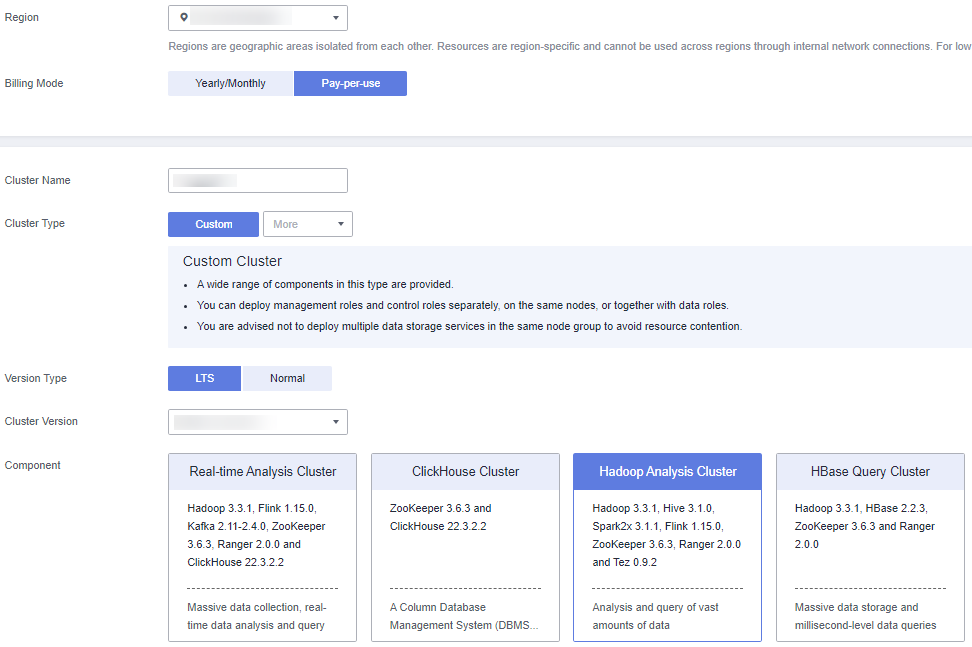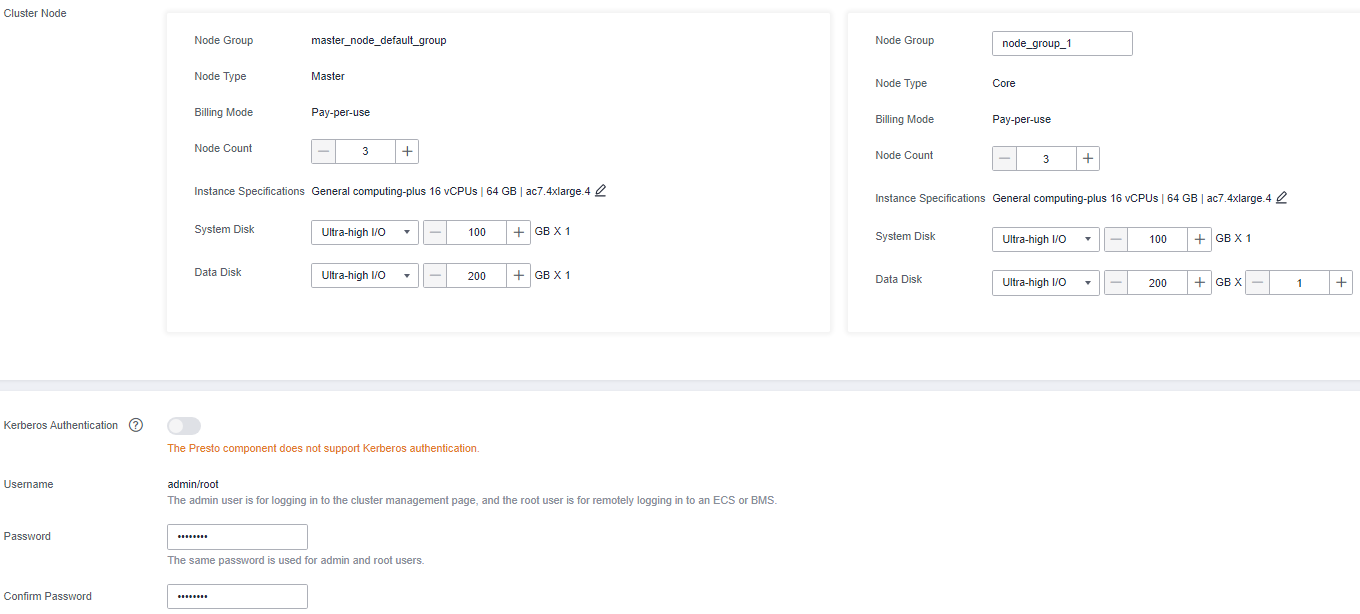Quickly Buying a Hadoop Analysis Cluster
This section describes how to quickly buy a Hadoop analysis cluster for analysis and query of vast amounts of data. In the open source Hadoop ecosystem, Hadoop uses YARN to manage cluster resources, Hive and Spark to provide offline storage and computing of large-scale distributed data, Spark Streaming and Flink to offer streaming data computing, and Presto to enable interactive queries, Tez to provide a distributed computing framework of directed acyclic graphs (DAGs).
The Hadoop analysis cluster consists of the following components:
- MRS 1.9.2: Hadoop 2.8.3, Spark 2.2.2, Hive 2.3.3, Presto 0.216, Tez 0.9.1, Ranger 1.0.1, and Flink 1.7.0.
- MRS 3.1.0: Hadoop 3.1.1, Hive 3.1.0, Spark2x 2.4.5, Flink 1.12.0, ZooKeeper 3.5.6, Ranger 2.0.0, Tez 0.9.2, and Presto 333.
- MRS 3.1.2-LTS.3: Hadoop 3.1.1, Hive 3.1.0, Spark2x 3.1.1, Flink 1.12.2, ZooKeeper 3.6.3, Ranger 2.0.0, and Tez 0.9.2.
- MRS 3.1.5: Hadoop 3.1.1, Hive 3.1.0, Spark2x 3.1.1, Tez 0.9.2, Flink 1.12.2, ZooKeeper 3.6.3, Ranger 2.0.0, and Presto 333.
Quickly Buying a Hadoop Analysis Cluster
- Go to the Buy Cluster page.
- On the displayed page, click the Quick Config tab.
- Configure basic cluster information. For details about the parameters, see Buying a Custom Cluster.
- Region: Use the default value.
- Billing Mode: Pay-per-use. If you select this mode, a prepaid balance will be frozen. For details, see Billing Description.
- Cluster Name: You can use the default name. However, you are advised to include a project name abbreviation or date for consolidated memory and easy distinguishing, for example, mrs_20180321.
- Cluster Type: Use the default value.
- Version Type: Normal is selected by default. (Components vary depending on the version type. Select a version type as needed.)
- Cluster Version: Select the latest version, which is the default value. (The components provided by a cluster vary according to the cluster version. Select a cluster version based on site requirements.)
- Component: Select Hadoop analysis cluster.
- AZ: Use the default value.
- Enterprise Project: Retain the default value.
- VPC: Use the default value. If there is no available VPC, click View VPC to access the VPC console and create a new VPC.
- Subnet: Use the default value.
- CPU Architecture: Use the default value.
- Cluster Node: Select the number of cluster nodes and node specifications based on site requirements. For MRS 3.x or later, the memory of the master node must be greater than 64 GB.
- Kerberos Authentication: Whether to enable Kerberos authentication. This option cannot be changed after you buy a cluster.
- Username: The default value is root/admin. User root is used to remotely log in to ECSs, and user admin is used to access the cluster management page.
- Password: Set a password for user root/admin.
- Confirm Password: Enter the password of user root/admin again.
Figure 1 Hadoop Analysis Cluster Figure 2 Cluster node configurations
Figure 2 Cluster node configurations
- Select the checkbox to enable secure communications. For details, see Communication Security Authorization.
- Click Buy Now.
If Kerberos authentication is enabled, check whether this function is required. If it is, click Continue. If not, click Back to disable it and then proceed with the subsequent step. This option cannot be changed after you buy a cluster.

For any doubt about the pricing, click Pricing details in the lower left corner.
- Click Back to Cluster List to view the cluster status. Click Access Cluster to view cluster details.
For details about cluster status during creation, see the description of the status parameters in Table 1.
It takes some time to create a cluster. The initial status of the cluster is Starting. After the cluster has been created successfully, the cluster status becomes Running.
On the MRS management console, a maximum of 10 clusters can be concurrently created, and a maximum of 100 clusters can be managed.
Feedback
Was this page helpful?
Provide feedbackThank you very much for your feedback. We will continue working to improve the documentation.See the reply and handling status in My Cloud VOC.
For any further questions, feel free to contact us through the chatbot.
Chatbot








